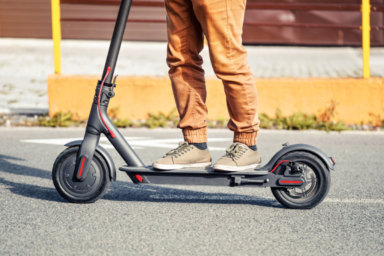How To Safely Store e-Bikes and e-Scooters : Tips for Charging Lithium-Ion Batteries

Getty Images
How To Safely Store e-Bikes and e-Scooters: Tips for Charging Lithium-Ion Batteries
Almost everywhere you look in NYC, someone uses an e-bike or e-scooter. Despite their popularity among New Yorkers of all ages, these devices contain lithium-ion batteries that have caused a recent rash of raging, damaging—and in some cases deadly-–fires around the city. You may be surprised to learn this, but you may have gear in your home that is being charged by lithium-ion batteries. As parents buy more e-scooters and VR systems for their kids -awareness of these batteries is a first step (for example, we had no idea we had one in our own home and only checked while this article was being written.) If you have an e-bike or e-scooter, knowing how to store them and charge their batteries safely is key to keeping your family and others safe.
What is a Lithium-ion Battery?
A lithium-ion battery is a type of energetic, rechargeable battery. They’re very popular lately because they have some advantages over other batteries. They’re lighter than other types of rechargeable batteries, they hold their charge and can handle hundreds of charge/discharge cycles. Certain smartphones and smart devices contain lithium-ion batteries, but e-bikes and e-scooters pose the biggest and most concerning threat when it comes to fire.
Psst..The Orchid Show Returns to NYBG for its 20th Year
The problem with these batteries is that they store a large amount of energy in a small amount of space. When batteries aren’t used the right way, or if they’re defective, they can be quite dangerous, fire officials say. They can overheat, catch fire or even explode. When fires like this occur, they burn very hot and are difficult for firefighters to extinguish.
“They take a lot of amperage. Most people don’t have a 20-amp outlet that it needs for the charging, Stephen Berger, a volunteer firefighter and former fire chief from Nassau County, said. “So, the mistake people make is they think it’s like a regular battery where you have a regular 15-amp outlet and charge it overnight. Then, it overheats and catches fire.”
E-bikes and similar devices still need to be charged in order to be used, of course. But it’s important to do so correctly and safely. For starters, never leave a charging device unattended.
“If you’re going to charge a lithium battery for an electric scooter or bike, charge it someplace where you can observe it. It should not be left unattended,” Berger said.
The dangers of lithium-ion batteries aren’t going unnoticed by lawmakers and authorities in city government. Officials including FDNY commissioner Laura Kavanagh are advocating for better regulation of e-bikes and e-scooters.
How to Safely Store e-Bikes and Charge Lithium-Ion Batteries
Fires caused by e-bikes and e-scooters happen with some regularity. In fact, the FDNY reported more than 130 such fires in 2022, and the numbers are rising. Electric bike batteries were the cause of several recent fires in NYC this year, too.
“Lithium-ion batteries power many of the products we use in our daily lives, by and large functioning without issue,” Brian O’Connor, a technical services engineer at the National Fire Protection Association (NFPA), said. “At the same time, lithium-ion batteries do pose potential fire risks, so it’s important to use and maintain them properly, and to be able to recognize signs of malfunction. That level of awareness can go a long way toward minimizing the likelihood of a fire.”
Fire prevention experts also recommend charging your e-bike or e-scooter outside the house.
“They don’t recommend you charge it inside the house, if possible. But if you do bring it in, sit there and watch it,” Berger explained.
Additional Safety Tips for Charging Lithium-Ion Batteries:
The NFPA recommends these safety tips for charging e-bikes, e-scooters and similar devices with lithium-ion batteries:
Purchase and use devices that are listed by a qualified testing laboratory.
Always follow the manufacturer’s instructions.
Only use the battery that is designed for the device.
Put batteries in the device the right way.
Only use the charging cord that came with the device.
Do not charge a device under your pillow or on your bed or couch.
Do not keep charging the device or device battery after it is fully charged.
Keep batteries at room temperature when possible. Do not charge them at temperatures below 32°F (0°C) or above 105°F (40°C).
Store batteries away from anything that can catch fire.
Additional Resources
The NFPA says to stop using a battery if you notice an odor, change in color, too much heat, change in shape, leaking or odd noises. If it’s safe to do so, move the device away from anything that can catch fire and call 911.
Never throw lithium-ion batteries in the trash. Take them to a battery recycling location. The NYC Department of Sanitation website has a lot of information on how to safely and legally dispose of batteries.
For more information about e-bike and fire prevention safety, visit nyc.gov or nfpa.org.



